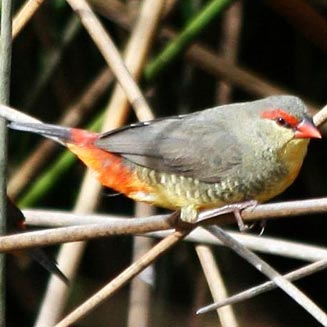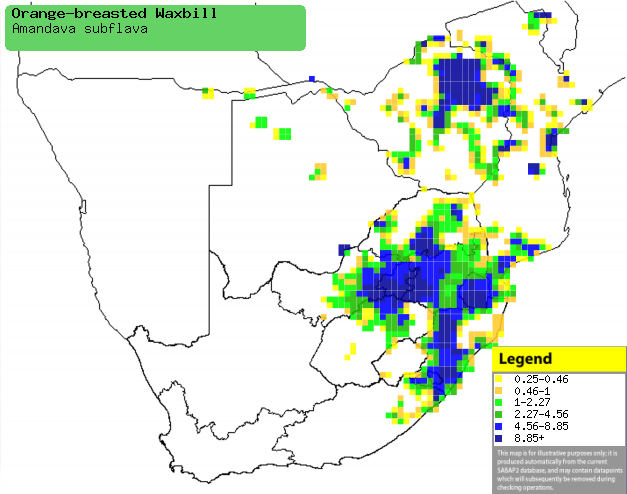|
Sporaeginthus subflavus
(Orange-breasted waxbill, Zebra waxbill)
[= Sporaeginthus subflavus]
Rooiassie [Afrikaans]; Katjikilili (applied to some of
waxbills and twinspots) [Kwangali]; Borahane, Borane (also aplied to other
waxbills and firefinches) [South Sotho]; Xidzingirhi (generic term for
firefinches and waxbills; also applied to Ground woodpecker [check])
[Tsonga]; Goudbuikje [Dutch]; Bengali zébré [French]; Goldbrüstchen
[German]; Bico-de-lacre-de-peito-laranja [Portuguese]
Life
> Eukaryotes >
Opisthokonta
> Metazoa (animals) >
Bilateria >
Deuterostomia > Chordata >
Craniata > Vertebrata (vertebrates) > Gnathostomata (jawed
vertebrates) > Teleostomi (teleost fish) > Osteichthyes (bony fish) > Class:
Sarcopterygii (lobe-finned
fish) > Stegocephalia (terrestrial
vertebrates) > Tetrapoda
(four-legged vertebrates) > Reptiliomorpha > Amniota >
Reptilia (reptiles) >
Romeriida > Diapsida > Archosauromorpha > Archosauria >
Dinosauria
(dinosaurs) > Saurischia > Theropoda (bipedal predatory dinosaurs) >
Coelurosauria > Maniraptora >Aves
(birds) > Order: Passeriformes
> Family: Estrildidae
 |
|
|
Orange-breasted waxbill, Cedara farm,
Pietermaritzburg, South Africa. [photo
Alan Manson
©] |
|
For information about this species, see
www.birdforum.net/opus/Zebra_Waxbill
Distribution and habitat
Occurs in patches across sub-Saharan Africa, from Senegal
to western Ethiopia south to southern Africa. Here it is locally common in
Mozambique, Zimbabwe and north-eastern and eastern South Africa, while rare in
northern Botswana and the Caprivi Strip (Namibia). It generally prefers moist
grassland, reedbeds, grassy savanna and rank vegetation on forest edges.
|
 |
|
Distribution of Orange-breasted waxbill in
southern Africa, based on statistical smoothing of the records from
first SA Bird Atlas Project (©
Animal Demography unit, University of
Cape Town; smoothing by Birgit Erni and Francesca Little). Colours range
from dark blue (most common) through to yellow (least common).
See here for the latest distribution
from the SABAP2. |
Predators and parasites
It (at different stages of development) has been recorded
as prey of the following animals:
- adults
- Thelotornis capensis (Savanna vinesnake)
- chicks and eggs
- Dasypeltis scabra (Common egg-eater)
- small raptors
- Lanius collaris (Common fiscal)
It has been recorded as host of these parasites:
- Myrsidea srivastava (feather lice)
- Passeromyia heterochaeta (Nest fly)
- Onychalges odonturus (feather mite)
- Ptilonyssus astridae (mite)
- Ornithophila metallica (hippoboscid fly)
Food
It mainly eats seeds taken directly from grass
inflorescences or the soil, supplemented with insects. The following food items have been recorded
in its diet:
- Grass seeds
- Digitaria milanjiana (Milanje finger grass)
- Hyparrhenia cymbaria (Thatching grass)
- Melinis repens (Natal red top)
- Panicum novenmere (Black-seed panicum)
- Setaria sphacelata (Moss African bristle grass)
- Insects
Breeding
- It usually uses the nest of another bird, especially
Southern red bishop but also
widowbirds,
weavers,
cisticolas and
prinias. It may add a new entrance
on the side if it was originally placed on the bottom, after which the
female lines the interior with feathers. The male may rarely build an untidy
ball-shaped nest instead, made of dry grass inflorescences, culms and leaves
and lined with finer material, such as feathers.
- Egg-laying season is from January-June, peaking from February-May.
- It lays 3-7 eggs, which are incubated by both sexes for about 13-14
days.
- The chicks are fed by both parents, leaving the nest after about 17-19
days and becoming fully independent about two weeks later.
Threats
Not threatened.
References
-
Hockey PAR, Dean WRJ and Ryan PG 2005. Roberts
- Birds of southern Africa, VIIth ed. The Trustees of the John Voelcker
Bird Book Fund, Cape Town.
|
